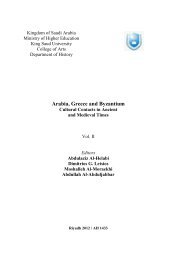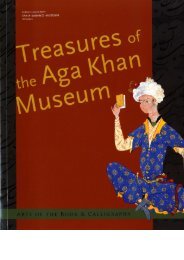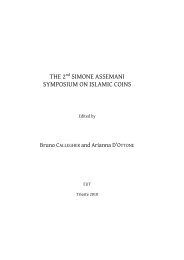ulum-al-quran
ulum-al-quran
ulum-al-quran
You also want an ePaper? Increase the reach of your titles
YUMPU automatically turns print PDFs into web optimized ePapers that Google loves.
dh<strong>al</strong>ika bi-anna minhum siddiqina wa ruhbana. [Ibn Abi Dawud., p. 103.]<br />
Muslim scholars have put forward a number of explanations and benefits for the Muslim umma deriving from the<br />
revelation of the Qur'anic message in sever<strong>al</strong> modes. Among these the following are most important:<br />
<br />
<br />
<br />
<br />
<br />
To make the reading, pronunciation and memorization more easy, as many people were illiterate in the<br />
Prophet's time.<br />
To unite the new Muslim community on the basis of one common language, the Arabic of the Quraish,<br />
with minor variations accepted, according to spoken language.<br />
To show something of the unique nature of the Qur'an, in the re<strong>al</strong>m of language.<br />
To show something of the unique nature of the Qur'an, in the re<strong>al</strong>m of meaning and leg<strong>al</strong> rulings.<br />
To explain a leg<strong>al</strong> ruling in more detail.<br />
Scholars Differ<br />
There is a difference of opinion among classic<strong>al</strong> Muslim scholars on the subject of the 'seven modes', to the extent that<br />
one of them was able to say: 'the degree of difference of opinion (ikhtilaf) among the scholars is to the extent of 35<br />
sayings'. [Itqan, I, p.45.]<br />
Some of these different opinions are that the 'seven modes' are:<br />
<br />
<br />
Different languages (di<strong>al</strong>ects) current among the Arabs at the time of revelation, such as e.g. Quraish, Hudhail,<br />
Tamim, etc., who had different ways of pronunciations which could even affect the spelling, e.g.<br />
<strong>al</strong>-tabuh and <strong>al</strong>-tabut. (2: 248) [See Kam<strong>al</strong>, op. cit., p.46.]<br />
or: hiyaka for iyaka (1:5).<br />
or: atta for hatta (12: 35).<br />
<br />
<br />
<br />
<br />
<br />
<br />
It may <strong>al</strong>so be the usage of words from the different languages in the Qur'an (this is considered one of the most<br />
sound views).<br />
Usage of synonyms in the Qur'an, i.e. that a variety of expressions describe one and the same concept. A wellknown<br />
example is Sura 101: 5, which reads as 'Ka-l-'ihni-l-manfush', but in another version 'Ka-s-sufi-l-manfush'<br />
both meaning 'like carded wool'. The word arshidna was read in place of ihdina (Sura 1: 6), etc. [Both examples<br />
from Ibn Mas'ud. This view is <strong>al</strong>so very close to the Idea of various di<strong>al</strong>ects. and many scholars tend to accept<br />
such usage of synonyms, as meaning the seven modes'.]<br />
Different aspects of the revelation, such as e.g. order, prohibitions, promise, narrations, etc.<br />
Seven differences, such as possible ways of reading words and structures in the Qur'an, e.g. the word 'trusts' in<br />
23: 8 which can be read both 'trust' (sg.) or 'trusts' (pl.) according to the plain text without vowels: li-amanatihim<br />
or li-amanatihim .<br />
Slightly different wordings of a particular passage, such as e.g. in 9: 100: 'Gardens under which rivers flow' which<br />
some read as 'Gardens from under which rivers flow', adding the word 'from' (min) to the text.<br />
Different ways of pronunciation as they have been explained in great detail by the scholars of qira'a (recitation)<br />
such as e.g. im<strong>al</strong>a, idgham, etc. [This view has <strong>al</strong>so been favoured by many, because it does not cause much<br />
controversy.]<br />
However, even non-Muslim orient<strong>al</strong>ists concede that 'no major differences of doctrines can be constructed on the basis of<br />
the par<strong>al</strong>lel readings based on the 'Uthmanic consonant<strong>al</strong> outline, yet ascribed to mushafs other than his. All the riv<strong>al</strong><br />
readings unquestionably represent one and the same text. They are substanti<strong>al</strong>ly agreed in what they transmit ...<br />
[Burton, J,: The Collection of the Qur’an, Cambridge. 1977, p. 171.]





